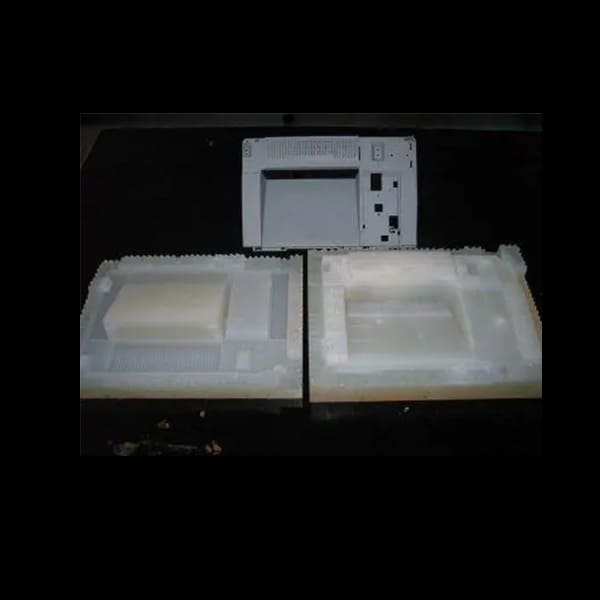Full analysis of silicone mold vacuum forming process

Master model production: the basis of accuracy
The vacuum forming process begins with the Master Model, whose accuracy and surface quality determine the final molded part.
– 3D printing (SLA/SLS ±0.1mm) is suitable for complex curved surfaces;
– CNC aluminum/epoxy models are prepared for high-precision silicone injection molding;
– Hand carving is mostly used for film and television props and artwork prototypes.
Key requirements: surface roughness Ra<1.6μm, 3–5° demoulding slope.
Silicone Mold Making: The Birth of Flexible Tools
Platinum vulcanized liquid silicone (Shore A20–60) is used to make elastic molds.
The main model is encapsulated: coated with release agent and fixed in the pouring frame;
Rubber mixing and degassing: Add catalyst and then vacuum degassing to eliminate bubbles;
Pouring and solidification: 24 hours at room temperature or 4 hours at 60°C;
Advantages: Flexible and can be deep drawn, resistant to high temperature cycles of 200°C, no need to apply release agent frequently.
Vacuum forming process: the leap from sheet to part
Heat the 0.5–5mm thermoplastic plate (ABS, PC, PETG) to 140–180°C to soften, and place it on top of the silicone mold.
– Start vacuum (90–95kPa) to absorb plastic and mold details such as threads and texture;
– The elasticity of the silicone mold compensates for heat shrinkage, and the dimensional accuracy can reach ±0.3mm;
– Non-stick surface reduces demoulding resistance, especially suitable for food-grade vacuum forming molds.
Cool and solidify: locking in size and performance
Accelerate cooling (30–120s) and utilize the thermal conductivity of silica gel (0.2W/m·K) to evenly dissipate heat.
– Infrared thermal imaging monitors temperature gradients to prevent internal stress;
– After cooling, the plastic adheres to the mold, ensuring detailed engraving.
Demolding and post-processing: Exquisite production
– Manual stretching: thanks to silicone elasticity, it can be easily peeled off without damaging details;
– Pneumatic ejector pin: 0.5–1bar air pressure ejection is optional for large-size molds;
– Trimming and finishing: CNC or die cutting machine to remove burrs, polishing, spraying or PVD surface treatment.
Small batch production and silicone injection molding connection
– A single mold can produce 50-100 pieces, suitable for rapid prototyping and small batches;
– Mold change time is less than 1 hour, far better than hard mold;
– Vacuum formed parts can be used as the main model for silicone injection molding to connect to mass production.
Silicone mold VS rigid vacuum forming mold comparison
– Cost: 30–50% lower for small batches;
– Details: Silicone is excellent, and its hardness depends on machining accuracy;
– Complexity: Silicone can be made into deep concave and upside-down shapes, and hardness is limited by the demoulding angle;
– Output: 50–100 pieces for silicone, 1000+ pieces for hard.
Process innovation
– Multi-hardness composite mold: Shore A20 and A80 areas are combined to meet special-shaped structures;
– Vacuum-assisted resin transfer molding (VARTM): a new application for composite parts;
– Digital mold optimization: AI predicts silicone wear and intelligently schedules maintenance.
Conclusion
By integrating silicone mold making, vacuum forming technology and silicone injection molding technology, manufacturers can achieve high precision, high efficiency and cost advantages in rapid prototyping and small batch production, and are widely used in medical devices, consumer electronics, automotive interiors and other fields. Silicone mold vacuum forming provides flexible and diverse solutions for modern manufacturing.

